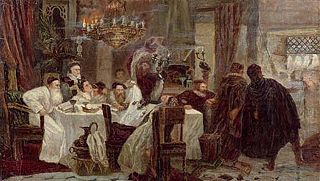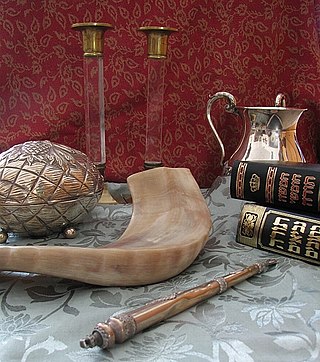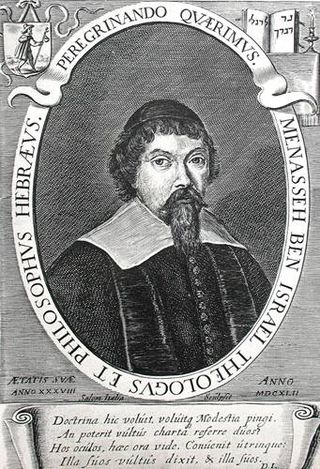
Sephardic Jews, also known as Sephardi Jews or Sephardim, and rarely as Iberian Peninsular Jews, are a Jewish diaspora population associated with the Iberian Peninsula. The term, which is derived from the Hebrew Sepharad, can also refer to the Jews of the Middle East and North Africa, who were also heavily influenced by Sephardic law and customs. Many Iberian Jewish exiled families also later sought refuge in those Jewish communities, resulting in ethnic and cultural integration with those communities over the span of many centuries. The majority of Sephardim live in Israel.

Marranos is a term for Spanish and Portuguese Jews who converted to Christianity, either voluntarily or by Spanish or Portuguese royal coercion, during the fifteenth and sixteenth centuries, but who continued to practice Judaism in secrecy or were suspected of it. They are also called crypto-Jews, the term increasingly preferred in scholarly works over Marranos.

Crypto-Judaism is the secret adherence to Judaism while publicly professing to be of another faith; practitioners are referred to as "crypto-Jews".

Manoel Dias Soeiro, better known by his Hebrew name Menasseh or Menashe ben Israel, was a Jewish scholar, rabbi, kabbalist, writer, diplomat, printer, publisher, and founder of the first Hebrew printing press in Amsterdam in 1626.
The resettlement of the Jews in England was an informal arrangement during the Commonwealth of England in the mid-1650s, which allowed Jews to practice their faith openly. It forms a prominent part of the history of the Jews in England. It happened directly after two events. Firstly a prominent rabbi Menasseh ben Israel came to the country from the Netherlands to make the case for Jewish resettlement, and secondly a Spanish New Christian merchant Antonio Robles requested that he be classified as a Jew rather than Spaniard during the war between England and Spain.

The Alhambra Decree was an edict issued on 31 March 1492, by the joint Catholic Monarchs of Spain ordering the expulsion of practising Jews from the Crowns of Castile and Aragon and its territories and possessions by 31 July of that year. The primary purpose was to eliminate the influence of practising Jews on Spain's large formerly-Jewish converso New Christian population, to ensure the latter and their descendants did not revert to Judaism. Over half of Spain's Jews had converted as a result of the religious persecution and pogroms which occurred in 1391. Due to continuing attacks, around 50,000 more had converted by 1415. A further number of those remaining chose to convert to avoid expulsion. As a result of the Alhambra Decree and persecution in the years leading up to the expulsion of Spain's estimated 300,000 Jewish origin population, a total of over 200,000 had converted to Roman Catholicism in order to remain in Spain, and between 40,000 and 100,000 remained Jewish and suffered expulsion. An unknown number of the expelled eventually succumbed to the pressures of life in exile away from formerly-Jewish relatives and networks back in Spain, and so converted to Roman Catholicism to be allowed to return in the years following expulsion.:17
Antonio Fernandez Carvajal —in Portuguese: António Fernandes Carvalhal—was a Portuguese-Jewish merchant, who became the first endenizened English Jew. Carvajal and Simon de Caceres, together with other prominent members of the Sephardic community, revealed themselves as Jews by signing a petition to Oliver Cromwell asking for the right to practise their religion and bury their dead. It was to Carvajal that Cromwell gave the assurance of the right of Jews to remain in England and who appointed Carvajal as the principal agent of the English Jews.
Spanish and Portuguese Jews, also called Western Sephardim, Iberian Jews, or Peninsular Jews, are a distinctive sub-group of Sephardic Jews who are largely descended from Jews who lived as New Christians in the Iberian Peninsula during the few centuries following the forced expulsion of unconverted Jews from Spain in 1492 and from Portugal in 1497. They should therefore be distinguished both from the descendants of those expelled in 1492 and from the present-day Jewish communities of Spain and Portugal.

Bevis Marks Synagogue, officially Qahal Kadosh Sha'ar ha-Shamayim, is an Orthodox Jewish congregation and synagogue, located off Bevis Marks, Aldgate, in the City of London, England, in the United Kingdom. The congregation is affiliated to London's historic Spanish and Portuguese Jewish community and worships in the Sephardic rite.
Isaac La Peyrère, also known as Isaac de La Peyrère or Pererius, was a French-born theologian, writer, and lawyer. La Peyrère is best known as a 17th-century predecessor of the scientific racialist theory of polygenism in the form of his Pre-Adamite hypothesis, which offered a challenge to traditional Abrahamic understandings of the descent of the human races as derived from the Book of Genesis. In addition to this, La Peyrère anticipated Zionism, advocating a Jewish return to Palestine, within the context of premillennialist Messianic theology. He moved in prominent circles and was known for his connections to the Prince of Condé and the abdicated Queen Christina of Sweden. Born to a Huguenot family, possibly of Portuguese Jewish converso or Marrano heritage, La Peyrère was pressured to renounce his views and publicly converted to the Catholic Church towards the end of his life, though the sincerity of this conversion has been questioned.

The history of the Jews in Portugal reaches back over two thousand years and is directly related to Sephardi history, a Jewish ethnic division that represents communities that originated in the Iberian Peninsula. In the sixteenth and seventeenth centuries, Portuguese Jews emigrated to a number of European cities outside Portugal, where they established new Portuguese Jewish communities, including in Hamburg, Antwerp, and the Netherlands, which remained connected culturally and economically, in an international commercial network during the seventeenth and eighteenth centuries.
The Whitehall Conference was a gathering of prominent English merchants, clergymen, and lawyers convened by Oliver Cromwell for the purpose of debating whether Jews should be readmitted to England. The conference lasted from 4 to 18 December 1655.

The community of Sephardic Jews in the Netherlands, particularly in Amsterdam, was of major importance in the seventeenth century. The Portuguese Jews in the Netherlands did not refer to themselves as "Sephardim", but rather as "Hebrews of the Portuguese Nation." The Portuguese-speaking community grew from conversos, Jews forced to convert to Catholicism in Spain and Portugal, who rejudaized under rabbinical authority, to create an openly self-identified Portuguese Jewish community. As a result of the expulsions from Spain in 1492 and Portugal in 1496, as well as the religious persecution by the Inquisition that followed, many Spanish and Portuguese Jews left the Iberian Peninsula at the end of the 15th century and throughout the 16th century, in search of religious freedom. Some migrated to the newly independent Dutch provinces which allowed Jews to become residents. Many Jews who left for the Dutch provinces were crypto-Jews. Others had been sincere New Christians, who, despite their conversion, were targeted by Old Christians as suspect. Some of these sought to return to the religion of their ancestors. Ashkenazi Jews began migrating to the Netherlands in the mid-seventeenth century, but Portuguese Jews viewed them with ambivalence.

Isaac Aboab da Fonseca was a rabbi, scholar, kabbalist, and religious writer. In 1656, he was one of several elders within the Portuguese-Jewish community in Amsterdam and for a time in Dutch Brazil before the Portuguese reconquest. He was one of the religious leaders who excommunicated philosopher Baruch Spinoza in 1656.
Antonio de Montezinos, also known as Aharon Levi or Aharon HaLevi, was a Portuguese traveler and a Converso Sephardic Jew who in 1644 persuaded Menasseh Ben Israel, a rabbi of Amsterdam, that he had found one of the Ten Lost Tribes of Israel living in the jungles of the "Quito Province" of Ecuador. This supposed discovery gave a new impulse to Menasseh's Messianic hopes. Menasseh wrote a book about this narrative, The Hope of Israel. In it Menasseh argued, and tried to give learned support to the theory that the native inhabitants of America at the time of the European discovery were actually descendants of the [lost] Ten Tribes of Israel. The book was originally published in Latin and Spanish in 1650, but its publication in English in 1652 in London caused great controversy and polemics in England.

Sephardic Jews in India are Iberian Jews who settled in many coastal towns of India, in Goa and Damaon, Madras and, primarily and for the longest period, on the Malabar coast in Cochin. After the Portuguese discovery of the sea route to India in the 1498, a number of Sephardic Jews fled Antisemitism in Iberia which had culminated in the Edict of Expulsion in 1492 and Persecution of Jews and Muslims by Manuel I of Portugal. They settled in Portuguese Indian trading places so that they could continue practicing Judaism secretly while still remaining within the Portuguese Empire. After the Portuguese Inquisition was established, an additional number of falsely-converted Sephardic Jews made sea voyages to settle in India, because it would then be difficult for the Inquisition to investigate and punish them. They spoke the vernacular language of their kingdom and some of them also Arabic.

On 5 December 1496, King Manuel I of Portugal signed the decree of expulsion of Jews and Muslims to take effect by the end of October of the next year.
Sephardic Bnei Anusim is a modern term which is used to define the contemporary Christian descendants of an estimated quarter of a million 15th-century Sephardic Jews who were coerced or forced to convert to Catholicism during the 14th and 15th centuries in Spain and Portugal. The vast majority of conversos remained in Spain and Portugal, and their descendants, who number in the millions, live in both of these countries. The small minority of conversos who emigrated normally chose to emigrate to destinations where Sephardic communities already existed, particularly to the Ottoman Empire and North Africa, but some of them emigrated to more tolerant cities in Europe, where many of them immediately reverted to Judaism. In theory, very few of them would have traveled to Latin America with colonial expeditions, because only those Spaniards who could certify that they had no recent Muslim or Jewish ancestry were supposed to be allowed to travel to the New World. Recent genetic studies suggest that the arrival of the Sephardic ancestors of Latin American populations coincided with the initial colonization of Latin America, which suggests that significant numbers of recent converts were able to travel to the new world and contribute to the gene pool of modern Latin American populations despite an official prohibition on them doing so. In addition, later arriving Spanish immigrants would have themselves contributed additional converso ancestry in some parts of Latin America.

The Lauderdale Road Spanish & Portuguese Synagogue, more commonly called the Lauderdale Road Synagogue, is an Orthodox Jewish congregation and synagogue, located in Maida Vale on Lauderdale Road in the City of Westminster, West London, England, in the United Kingdom.

The Velho Cemetery is a disused Jewish burial ground in Mile End, London. It is the oldest surviving Jewish cemetery in the United Kingdom, founded in 1657 by members of the Creechurch Lane synagogue, which was itself the first synagogue to be established in the country since the 1290 expulsion of the Jews. The land for the cemetery was paid for by Antonio Fernandez Carvajal and Simon de Cacares.












